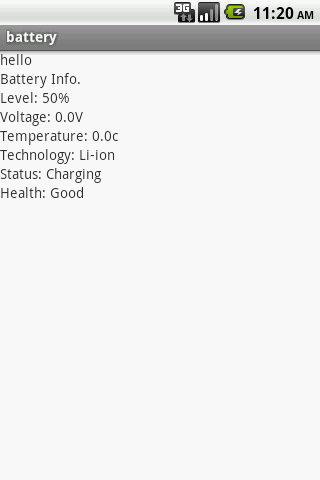- Internal storage are private to your application and other applications cannot access them (nor can the user).
- When the user uninstalls your application, these files are removed.
- External storage such as SD card can also store application data.
- There's no security enforced upon files you save to the external storage.
- All applications can read and write files placed on the external storage and the user can remove them.
- You need Read and Write permission in External Storage
In this example we are going to save data from an EditText to both
Internal Storage and External Storage, and then try to get the data back
from the respective storage places.
FileOutputStream :For save Data
FileInputStream :For Display data
Layout -
activity_main.xml
<?xml version="1.0" encoding="utf-8"?>
<LinearLayout xmlns:android="http://schemas.android.com/apk/res/android"
android:layout_width="fill_parent"
android:layout_height="fill_parent"
android:orientation="vertical" >
<TextView
android:layout_width="fill_parent"
android:layout_height="wrap_content"
android:text="Storage Demo" />
<EditText
android:id="@+id/InputText"
android:layout_width="match_parent"
android:layout_height="wrap_content"
android:ems="10"
android:gravity="top|left"
android:inputType="textMultiLine"
android:lines="5"
android:minLines="2"
android:text="Internal and External Storage" >
<requestFocus />
</EditText>
<Button
android:id="@+id/InternalStorageSave"
android:layout_width="match_parent"
android:layout_height="wrap_content"
android:text="Internal Storage(Save)" />
<Button
android:id="@+id/InternalStorageGet"
android:layout_width="match_parent"
android:layout_height="wrap_content"
android:text="Internal Storage(Display)" />
<Button
android:id="@+id/ExternalStorageSave"
android:layout_width="match_parent"
android:layout_height="wrap_content"
android:text="External Storage(Save)" />
<Button
android:id="@+id/ExternalStorageGet"
android:layout_width="match_parent"
android:layout_height="wrap_content"
android:text="External Storage(Displays)" />
<TextView
android:id="@+id/responseText"
android:layout_width="wrap_content"
android:layout_height="wrap_content"
android:padding="5dp"
android:text=""
android:textAppearance="?android:attr/textAppearanceMedium" />
</LinearLayout>
Activity - MainActivity.java
import java.io.BufferedReader;
import java.io.DataInputStream;
import java.io.File;
import java.io.FileInputStream;
import java.io.FileOutputStream;
import java.io.IOException;
import java.io.InputStreamReader;
import android.app.Activity;
import android.content.Context;
import android.content.ContextWrapper;
import android.os.Bundle;
import android.os.Environment;
import android.view.View;
import android.view.View.OnClickListener;
import android.widget.Button;
import android.widget.EditText;
import android.widget.TextView;
public class MainActivity extends Activity implements OnClickListener {
private String filename = "StorageFile.txt";
private String filepath = "FileStorage";
File myInternalFile;
File myExternalFile;
@Override
public void onCreate(Bundle savedInstanceState) {
super.onCreate(savedInstanceState);
setContentView(R.layout.activity_main);
ContextWrapper contextWrapper = new ContextWrapper(
getApplicationContext());
File directory = contextWrapper.getDir(filepath, Context.MODE_PRIVATE);
myInternalFile = new File(directory, filename);
Button saveToInternalStorage = (Button) findViewById(R.id.InternalStorageSave);
saveToInternalStorage.setOnClickListener(this);
Button readFromInternalStorage = (Button) findViewById(R.id.InternalStorageGet);
readFromInternalStorage.setOnClickListener(this);
Button saveToExternalStorage = (Button) findViewById(R.id.ExternalStorageSave);
saveToExternalStorage.setOnClickListener(this);
Button readFromExternalStorage = (Button) findViewById(R.id.ExternalStorageGet);
readFromExternalStorage.setOnClickListener(this);
// check if external storage is available and not read only
if (!isExternalStorageAvailable() || isExternalStorageReadOnly()) {
saveToExternalStorage.setEnabled(false);
} else {
myExternalFile = new File(getExternalFilesDir(filepath), filename);
}
}
public void onClick(View v) {
EditText myInputText = (EditText) findViewById(R.id.InputText);
TextView responseText = (TextView) findViewById(R.id.responseText);
String myData = "";
switch (v.getId()) {
case R.id.InternalStorageSave:
try {
FileOutputStream fos = new FileOutputStream(myInternalFile); // save
fos.write(myInputText.getText().toString().getBytes());
fos.close();
} catch (IOException e) {
e.printStackTrace();
}
myInputText.setText("");
responseText.setText("Saved to Internal Storage.(StorageFile.txt)");
break;
case R.id.InternalStorageGet:
try {
FileInputStream fis = new FileInputStream(myInternalFile); // display
DataInputStream in = new DataInputStream(fis);
BufferedReader br = new BufferedReader(
new InputStreamReader(in));
String strLine;
while ((strLine = br.readLine()) != null) {
myData = myData + strLine;
}
in.close();
} catch (IOException e) {
e.printStackTrace();
}
myInputText.setText(myData);
responseText
.setText("Data retrieved from Internal Storage.(StorageFile.txt)");
break;
case R.id.ExternalStorageSave:
try {
FileOutputStream fos = new FileOutputStream(myExternalFile);
fos.write(myInputText.getText().toString().getBytes());
fos.close();
} catch (IOException e) {
e.printStackTrace();
}
myInputText.setText("");
responseText.setText("Saved to External Storage.(StorageFile.txt)");
break;
case R.id.ExternalStorageGet:
try {
FileInputStream fis = new FileInputStream(myExternalFile);
DataInputStream in = new DataInputStream(fis);
BufferedReader br = new BufferedReader(
new InputStreamReader(in));
String strLine;
while ((strLine = br.readLine()) != null) {
myData = myData + strLine;
}
in.close();
} catch (IOException e) {
e.printStackTrace();
}
myInputText.setText(myData);
responseText
.setText("Data retrieved from Internal Storage.(StorageFile.txt)");
break;
}
}
private static boolean isExternalStorageReadOnly() {
String extStorageState = Environment.getExternalStorageState();
if (Environment.MEDIA_MOUNTED_READ_ONLY.equals(extStorageState)) {
return true;
}
return false;
}
private static boolean isExternalStorageAvailable() {
String extStorageState = Environment.getExternalStorageState();
if (Environment.MEDIA_MOUNTED.equals(extStorageState)) {
return true;
}
return false;
}
}
<uses-permission android:name="android.permission.WRITE_EXTERNAL_STORAGE"/>
<uses-permission android:name="android.permission.READ_EXTERNAL_STORAGE"/>





